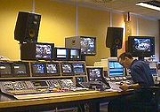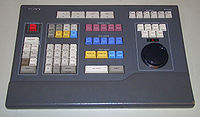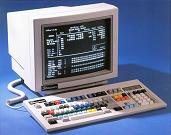
Linear video editing
Encyclopedia

Video editing
The term video editing can refer to:* Linear video editing, using video tape* Non-linear editing system , using computers with video editing software* Offline editing* Online editing...
post-production
Post-production
Post-production is part of filmmaking and the video production process. It occurs in the making of motion pictures, television programs, radio programs, advertising, audio recordings, photography, and digital art...
process of selecting, arranging and modifying images and sound in a predetermined, ordered sequence
Sequence
In mathematics, a sequence is an ordered list of objects . Like a set, it contains members , and the number of terms is called the length of the sequence. Unlike a set, order matters, and exactly the same elements can appear multiple times at different positions in the sequence...
. Regardless whether captured by a video camera
Video camera
A video camera is a camera used for electronic motion picture acquisition, initially developed by the television industry but now common in other applications as well. The earliest video cameras were those of John Logie Baird, based on the electromechanical Nipkow disk and used by the BBC in...
, tapeless camcorder
Tapeless Camcorder
A tapeless camcorder is a camcorder that does not use video tape for the digital recording of video productions as 20th century ones did. Tapeless camcorders record video as digital computer files onto random access data storage devices such as optical discs, hard disk drives and solid-state flash...
, recorded in a television studio
Television studio
A television studio is an installation in which a video productions take place, either for the recording of live television to video tape, or for the acquisition of raw footage for post-production. The design of a studio is similar to, and derived from, movie studios, with a few amendments for the...
on a video tape recorder
Video tape recorder
A video tape recorder is a tape recorder that can record video material, usually on a magnetic tape. VTRs originated as individual tape reels, serving as a replacement for motion picture film stock and making recording for television applications cheaper and quicker. An improved form included the...
(VTR) the content must be accessed sequentially
Sequential access
In computer science, sequential access means that a group of elements is accessed in a predetermined, ordered sequence. Sequential access is sometimes the only way of accessing the data, for example if it is on a tape...
. For the most part video editing software
Video editing software
Video editing software, is application software which handles the post-production video editing of digital video sequences on a computer non-linear editing systems...
has replaced linear editing.
Until the advent of computer-based random access
Random access
In computer science, random access is the ability to access an element at an arbitrary position in a sequence in equal time, independent of sequence size. The position is arbitrary in the sense that it is unpredictable, thus the use of the term "random" in "random access"...
non-linear editing system
Non-linear editing system
In video, a non-linear editing system is a video editing or audio editing digital audio workstation system which can perform random access non-destructive editing on the source material...
s (NLE) in the early 1990s "linear video editing" was simply called "video editing
Video editing
The term video editing can refer to:* Linear video editing, using video tape* Non-linear editing system , using computers with video editing software* Offline editing* Online editing...
".
History
Actual live televisionLive television
Live television refers to a television production broadcast in real-time, as events happen, in the present. From the early days of television until about 1958, live television was used heavily, except for filmed shows such as I Love Lucy and Gunsmoke. Video tape did not exist until 1957...
is still basically produced in the same manner as it was in the 1950s, although transformed by modern technical advances. Before videotape, the only way of airing the same shows again was by filming shows using a kinescope
Kinescope
Kinescope , shortened to kine , also known as telerecording in Britain, is a recording of a television program made by filming the picture from a video monitor...
, essentially a video monitor
Video monitor
A video monitor also called a broadcast monitor, broadcast reference monitor or just reference monitor, is a display device similar to a television set, used to monitor the output of a video-generating device, such as playout from a video server, IRD, video camera, VCR, or DVD player. It may or...
paired with a movie camera. However, kinescopes (the films of television shows) suffered from various sorts of picture degradation, from image distortion and apparent scan line
Scan line
A scan line or scanline is one line, or row, in a raster scanning pattern, such as a line of video on a cathode ray tube display of a television set or computer monitor....
s to artifacts in contrast and loss of detail. Kinescopes had to be processed and printed in a film laboratory, making them unreliable for broadcasts delayed for different time zones.
The primary motivation for the development of video tape was as a short or long-term archival medium. Only after a series of technical advances spanning decades did video tape editing finally become a viable production tool, up to par with film editing.
Early technology
The first widely accepted video tape in the United States was 2 inch Quadruplex videotape and traveled at 15 inches per second. To gain enough head-to-tape speed, four video recording and playback heads were spun on a head wheel across most of the two-inch width of the tape. (Audio and synchronization tracks were recorded along the sides of the tape with stationary heads.) This system was known as Quad, for quadruplex recording.The resulting video tracks were slightly less than a ninety-degree angle (considering the vector addition of high-speed spinning heads tracing across the 15 inches per second forward motion of the tape).
Originally, video was edited by visualizing the recorded track with ferrofluid
Ferrofluid
A ferrofluid is a liquid which becomes strongly magnetized in the presence of a magnetic field.Ferrofluids are colloidal liquids made of nanoscale ferromagnetic, or ferrimagnetic, particles suspended in a carrier fluid . Each tiny particle is thoroughly coated with a surfactant to inhibit clumping...
and cutting it with a razor blade
Razor blade
Razor blade may refer to* A razor* The Razor Blade, a 1920s racing car* Razor blade steel, a type of steel originally designed specifically for razor blades...
or guillotine
Guillotine
The guillotine is a device used for carrying out :executions by decapitation. It consists of a tall upright frame from which an angled blade is suspended. This blade is raised with a rope and then allowed to drop, severing the head from the body...
cutter and splicing with video tape, in a manner similar to film editing
Film editing
Film editing is part of the creative post-production process of filmmaking. It involves the selection and combining of shots into sequences, and ultimately creating a finished motion picture. It is an art of storytelling...
. This was an arduous process and avoided where possible. When it was used, the two pieces of tape to be joined were painted with a solution of extremely fine iron filings suspended in carbon tetrachloride
Carbon tetrachloride
Carbon tetrachloride, also known by many other names is the organic compound with the formula CCl4. It was formerly widely used in fire extinguishers, as a precursor to refrigerants, and as a cleaning agent...
, a toxic and carcinogenic compound. This "developed" the magnetic tracks, making them visible when viewed through a microscope
Microscope
A microscope is an instrument used to see objects that are too small for the naked eye. The science of investigating small objects using such an instrument is called microscopy...
so that they could be aligned in a splicer designed for this task. The tracks had to be cut during a vertical retrace, without disturbing the odd-field/even-field ordering. The cut also had to be at the same angle that the video tracks were laid down on the tape. Since the video and audio read heads were several inches apart it was not possible to make a physical edit that would function correctly in both video and audio. The cut was made for video and a portion of audio then re-copied into the correct relationship, the same technique as for editing 16mm film with a combined magnetic audio track.
The disadvantages of physically editing tapes were many. Some broadcasters decreed that edited tapes could not be reused, in an era when the relatively high cost of the machines and tapes was balanced by the savings involved in being able to wipe and reuse the media. Others, such as the BBC
BBC
The British Broadcasting Corporation is a British public service broadcaster. Its headquarters is at Broadcasting House in the City of Westminster, London. It is the largest broadcaster in the world, with about 23,000 staff...
, allowed reuse of spliced tape in certain circumstances as long as it conformed to strict criteria about the number of splices in a given duration. The process required great skill, and often resulted in edits that would roll (lose sync) and each edit required several minutes to perform, although this was also initially true of the electronic editing that came later.
In the USA, the television show Rowan & Martin's Laugh-In
Rowan & Martin's Laugh-In
Rowan & Martin's Laugh-In is an American sketch comedy television program which ran for 140 episodes from January 22, 1968, to May 14, 1973. It was hosted by comedians Dan Rowan and Dick Martin and was broadcast over NBC...
was the first and possibly only TV show to make extensive use of splice editing of videotape.
Introduction of computerized systems
A system for editing Quad tape "by hand" was developed by the 1960s. It was really just a means of synchronizing the playback of two machines so that the signal of the new shot could be "punched in" similar to with a reasonable chance at success. One problem with this and early computer-controlled systems was that the audio track was prone to suffer artifacts (i.e. a short buzzing sound) because the video of the newly-recorded shot would record into the side of the audio track. A commercial solution known as "Buzz Off" was used to minimize this effect.For more than a decade, computer-controlled Quad editing systems were the standard post-production tool for television. Quad tape involved expensive hardware, time-consuming setup, relatively long rollback times for each edit and showed misalignment as disagreeable "banding" in the video. That said, it should be mentioned that Quad tape has a better bandwidth than any smaller-format analogue tape, and properly handled could produce a picture indistinguishable from that of a live camera.
Further advancement in technology

Helical scan
Helical scan is a method of recording high bandwidth signals onto magnetic tape. It is used in reel-to-reel video tape recorders, video cassette recorders, digital audio tape recorders, and some computer tape drives....
video recorders became the standard it was no longer possible to physically cut the tape. At this point video editing became a process of using two video tape machines
Video tape recorder
A video tape recorder is a tape recorder that can record video material, usually on a magnetic tape. VTRs originated as individual tape reels, serving as a replacement for motion picture film stock and making recording for television applications cheaper and quicker. An improved form included the...
, playing back the source tape (or "raw footage
Footage
In filmmaking and video production, footage is the raw, unedited material as it had been originally filmed by movie camera or recorded by a video camera which usually must be edited to create a motion picture, video clip, television show or similar completed work...
") from one machine and copying just the portions desired on to a second tape (the "edit master").
The bulk of linear editing is done simply, with two machines and a edit controller device to control them. Many video tape machines are capable of controlling a second machine, eliminating the need for an external editing control device.
This process is "linear", rather than non-linear editing, as the nature of the tape-to-tape copying requires that all shots be laid out in the final edited order. Once a shot is on tape, nothing can be placed ahead of it without overwriting whatever is there already. If absolutely necessary, material can be dubbed
Dubbing (music)
In sound recording, dubbing is the transfer or copying of previously recorded audio material from one medium to another of the same or a different type. It may be done with a machine designed for this purpose, or by connecting two different machines: one to play back and one to record the signal...
inserted by copying the edited content onto another tape, however as each copy introduced generation-produced image degradation this is not desirable.
One drawback of early video editing technique was that it was impractical to produce a rough cut
Rough cut
In filmmaking, the rough cut is the second of three stages of offline editing. The rough cut is the first stage in which the film begins to resemble its final product...
for presentation to an Executive producer
Executive producer
An executive producer is a producer who is not involved in any technical aspects of the film making or music process, but who is still responsible for the overall production...
. Since Executive Producers are never familiar enough with the material to be able to visualise the finished product from inspection of a edit decision list
Edit decision list
An edit decision list or EDL used in the post-production process of film editing and video editing. The list contains an ordered list of reel and timecode data representing where each video clip can be obtained in order to conform the final cut....
(EDL), they were deprived of the opportunity to voice their opinions at a time when those opinions could be easily acted upon. Thus, particularly in documentary television, video was resisted for quite a long time.
Peak usage
Video editing reached its full potential in the late 1970s when computer-controlled minicomputer edit controllers along with communications protocolCommunications protocol
A communications protocol is a system of digital message formats and rules for exchanging those messages in or between computing systems and in telecommunications...
s were developed, which could orchestrate an edit based on an EDL, using timecode to synchronize multiple tape machines and auxiliary devices using a 9-Pin Protocol
9-Pin Protocol
The 9-Pin Protocol is a two-way communications protocol for the RS-422 D-sub electrical connector interface, in which a bi-direction signal is transmitted over a single, four wire, serial cable to allow the remote control of a wide variety of devices including, reel-to-reel type C videotape video...
. The most popular and widely used computer edit systems came from Sony
Sony
, commonly referred to as Sony, is a Japanese multinational conglomerate corporation headquartered in Minato, Tokyo, Japan and the world's fifth largest media conglomerate measured by revenues....
, Ampex
Ampex
Ampex is an American electronics company founded in 1944 by Alexander M. Poniatoff. The name AMPEX is an acronym, created by its founder, which stands for Alexander M. Poniatoff Excellence...
and the venerable CMX
CMX Systems
CMX Editing Systems was a company founded jointly by CBS and Memorex, that developed some of the very first computerized systems for linear and non-linear editing of videotape for post production...
. Systems such as these were expensive, especially when considering auxiliary equipment like VTR, video switchers and character generator
Character generator
A character generator, often abbreviated as CG, is a device or software that produces static or animated text for keying into a video stream. Modern character generators are computer-based, and can generate graphics as well as text...
s (CG) and were usually limited to high-end post-production
Post-production
Post-production is part of filmmaking and the video production process. It occurs in the making of motion pictures, television programs, radio programs, advertising, audio recordings, photography, and digital art...
facilities.

Strassner Editing Systems
No longer in production, Strassner Editing Systems was a line of PC-based linear "CMX style" keyboard video editing controllers invented in 1988 by Norman H. Strassner in Los Angeles, CA. Over 400 systems were sold up to the time, in 1995, that Mr...
, came out with equally useful competing editing products.
Current usage
While computer based Video editing softwareVideo editing software
Video editing software, is application software which handles the post-production video editing of digital video sequences on a computer non-linear editing systems...
has been adopted throughout most of the commercial, film
Film
A film, also called a movie or motion picture, is a series of still or moving images. It is produced by recording photographic images with cameras, or by creating images using animation techniques or visual effects...
, industrial and consumer video industries, linear video tape editing is still commonplace in television station
Television station
A television station is a business, organisation or other such as an amateur television operator that transmits content over terrestrial television. A television transmission can be by analog television signals or, more recently, by digital television. Broadcast television systems standards are...
newsroom
Newsroom
A newsroom is the place where journalists—reporters, editors, and producers, along with other staffers—work to gather news to be published in a newspaper or magazine or broadcast on television, cable or radio...
s for the production of television news, and medium-sized production facilities which haven’t made the capital investment in newer technologies. News departments often still use linear editing because they can start editing tape and feeds from the field as soon as received since no additional time is spent capturing material as is necessary in non-linear editing systems and systems that are able to digitally record and edit simultaneously have only recently become affordable for small operations.

